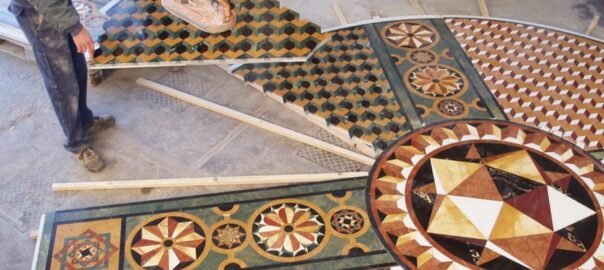
Marble inlay is a closely protected traditional art and only a few expert are skilled enough to do justice to it in this day and age. The delicate process involves carefully cutting and engraving marble shapes by hand.
One of the things that make the Taj Mahal so wondrous and special is the marble inlay work you find on it. In fact, you find this beautiful art form on other Mughal monuments too.
Marble inlay is a closely protected traditional art and only a few expert are skilled enough to do justice to it in this day and age. The delicate process involves carefully cutting and engraving marble shapes by hand. Roughly speaking, this is how it works.
To begin with, a predefined pattern, like say, a floral or geometrical design is engraved on the marble slab. After this, small pieces of marble of different shades are cut delicately to precisely fit and slipped into these grooves. Apart from marble, many other materials can also be used to adorn the marble inlay spaces.
The Italian Connection
Inlay work on delicate precious stone began in the workshops of Florence in Italy around the end of the 16th century. This was known as PIETRA DURA, which means hard (dura) stone (pietra).
The Italians created an art form that the world came to appreciate and pietra dura appeared on a range of objects from decorative panels to hand-carved bird to flower motifs to cabinet fronts to table tops to presents from travelers to Emperors in the resplendent Mughal courts in faraway India.
Of all the Mughal Emperors, Shah Jahan was the greatest patron of the arts in general and architecture, in particular. For him no amount of money or time was too much to create enduring, everlasting architectural wonders that would wow the world and stand the test of centuries of time. It is in his buildings that one sees the confluence of Mughal art and Italian pietra dura.
Above all, the Taj Mahal, the cenotaphs of the Emperor and his wife, the main floor and the surrounding marble railings, all bear very close resemblances to the pietra dura form of inlay work.
Surface matters
White marble from Makrana, Rajasthan (India) or Creama Marble from Italy is the most preferred form of surface for inlay work. If for any reason, marble is not the chosen one, black kadappa stone or green marble is taken up.
Inlay work begins with a design – it could be a motif that’s floral or geometrical – which is cut out on a brass sheet. This is then placed on marble and drawn. Next, the marble is carved out. Slices of coloured stones (precious and less-precious), which have in the meantime been shaped and polished, are then delicately laid into the marble with adhesive. At times, a heat treatment is given to particular stone to get a shading effect, e.g. heating Jaisalmer (Yellow) stone to get a red colour.
Getting stoned
Here is a non-exhaustive list of the types of natural stones normally used for inlay on marble: White Jasper, Chocolate Stone, Green Marble, Sang-a- Mariam, Tiger Stone, Red Jasper, Lapis, Green Aventurine, Yellow Aventurine, Black Onyx, Green Bidasar, Dark Green Bidasar, Brown Bidasar, Yellow Bidasar, Cobra Stone, Malachite, Ruby, Jaiselmer Red (Heated), Jaisalmer Yellow, Creama Marble, Alikantak, Green Laventure, Torques (Firoza), and Amethyst.
Polish it up
Once the inlay work is completed and has dried, it’s time for the surface and edges to be polished and shined. In order to give it a shine that lasts for decades, the polish work is done using a stone bar. It is now ready-to-go.



